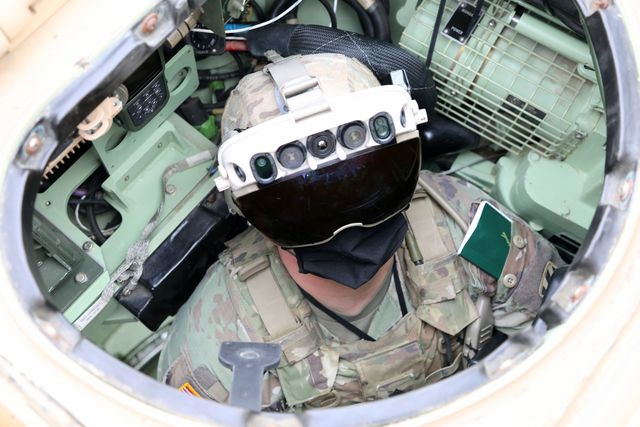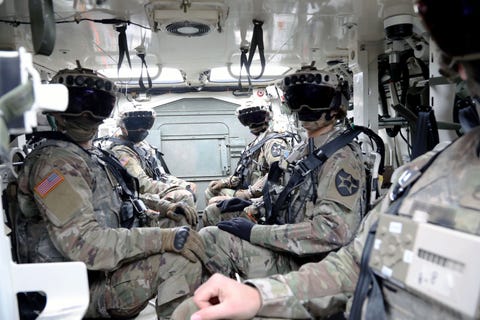- Get link
- X
- Other Apps
The Army’s New Goggles Let Soldiers See Right Through Walls
Now, infantry troops will know exactly where they're going on the battlefield.

DVIDS
- The Army’s new Integrated Augmented Vision System (IAVS) goggles can incorporate feeds from the cameras mounted on the outside of Army vehicles.
- Now, soldiers in the back of infantry fighting vehicles can tell exactly where they are and where they’re going.
- Eventually, the Army wants to buy 40,000 IAVS sets to equip soldiers worldwide.
The U.S. Army’s new goggles can help soldiers see right through the walls of combat vehicles, which means infantry troops will have unparalleled situational awareness.
The Army is developing its Integrated Augmented Vision System (IAVS) goggles for close-combat forces, including mounted and dismounted troops, particularly infantry. The service hopes to field tens of thousands of the goggles, which can also help soldiers see in the dark, check around corners, and even project digital maps and other data onto the lenses.
This content is imported from {embed-name}. You may be able to find the same content in another format, or you may be able to find more information, at their web site.
Because these goggles access feeds from the omnidirectional cameras mounted on the outside of armored vehicles, a squad of six soldiers, nestled safely in the back of a Bradley or Stryker infantry vehicle, can “see” through the walls of the car, getting a clear picture of the scene.

U.S. ARMY PHOTO BY BRIDGETT SITER
“Now guys aren’t hanging out of vehicles in dangerous situations trying to get views on what’s going on,” Sgt. Philip Bartel of the 1-2 Stryker Brigade Combat Team told the Army. He continued:
“Leadership will be able to maneuver their elements and get view-on-target without having to leave the safety of their armored vehicles. Maneuvering elements with that kind of information will minimize casualties and will overall drastically change how we operate and increase our effectiveness on the battlefield.”

DVIDS
The Army designed the IAVS goggles to act in a similar manner to the heads-up displays (HUD) on fighter jets. Like an HUD, the IAVS goggles project information including maps, video, and night vision across the soldier’s field of view.
Soldiers have always had that sort of data at their disposal, but IAVS now gives them instant access, which is particularly useful during combat. Instead of digging through their pockets for a laminated paper map, soldiers can quickly call up a digital map on IAVS without taking their eyes away from the objective.
IAVS can also use a rifle-mounted thermal imaging night vision scope to project the soldiers’ surroundings across their field of vision. A soldier can point a rifle from behind cover or around corners and see through the scope, gaining a view that would otherwise expose the soldier to enemy fire. Soldiers can even use IAVS to access microdrone cameras as they fly over the battlefield.

U.S. ARMY
A 2020 report on the IAVS system describes how soldiers train with the system. According to the Director, Operational Test & Environment (the department of the Pentagon that evaluates new equipment), soldiers with IAVS can:
Enter and clear six rooms as a team in a real-world building with virtual Synthetic Training Environment targets and content using synthetic M4 airsoft rifles and trackers. Following each experiment run through, warfighters received feedback about their performance including shots taken, kills, and shots received. Warfighters could replay their actions as avatars in a virtual after-action review.
With IAVS, even mounted soldiers can see outside their vehicles.
Mechanized infantry, cavalry, and engineers all typically ride in the back of armored vehicles, for example. They know where they’re going, and where they’re supposed to be, but the soldiers often rely on a single screen or vehicle crews to let them know where they are in real time.
Once the vehicle stops and the ramp comes down, the soldiers must quickly acclimate to their surroundings, determine where the enemy is, and orient themselves to carry out the mission.

DVIDS
The Army is bullish on the IAVS system and requested to spend $1.1 billion to buy 40,000 of them—enough to equip every frontline soldier in the Army. Congress pumped the brakes on the program this year, cutting the requested budget by 20 percent. But the Army has already resolved many of the issues that concerned lawmakers, according to Jane’s.
- Get link
- X
- Other Apps
Comments
Post a Comment